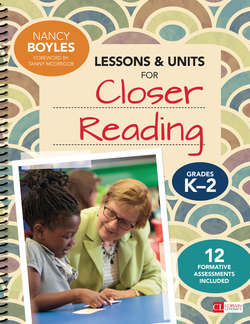Читать книгу Lessons and Units for Closer Reading, Grades K-2 - Nancy Boyles - Страница 7
На сайте Литреса книга снята с продажи.
Contents
Оглавление1 Foreword
2 Acknowledgments
3 Reading Closely in K–2: Guidelines for Getting Started1. Rely on high-quality picture books that you read aloud.2. Teach an initial close reading lesson to build content knowledge.3. Teach close reading follow-up lessons to build skills.4. Assess close reading appropriately with formative assessments.5. Teach close reading using units so students can make connections between texts.6. Teach close reading using learning pathways that show students how to learn.
4 Teaching and Assessing Students’ ComprehensionThe Twelve Skills in FocusHow the Assessments Are Embedded Across Books and UnitsHow the Assessments Are Embedded in Weekly InstructionDuring Reading Success: It’s in the CardsAfter Reading Success: Framing Students’ ThinkingHow to Evaluate Students’ Written ResponsesRubric for Evaluating Reader Response Frames
5 Standards: Putting the Assessment Tools to Work
6 The Reproducibles: Active Reader Cards and Reader Response Frames
7 Student-Friendly Forms for Teaching and Assessing the StandardsNotice Key Details in a Text: Active Reader CardsNotice Key Details in a Text: Reader Response FrameSummarize a Story: Active Reader CardsSummarize a Story: Reader Response FrameIdentify Details That Support a Central Idea: Active Reader CardsIdentify Details That Support a Central Idea: Reader Response FrameIdentify Character Traits and Feelings: Active Reader ChartsIdentify Character Traits and Feelings: Reader Response FrameIdentify Cause and Effect: Active Reader CardsIdentify Cause and Effect: Reader Response FrameIdentify Important Word Meanings: Active Reader ChartIdentify Important Word Meanings: Reader Response FrameIdentify the Kind of Information in This Part of the Text: Active Reader CardsIdentify the Kind of Information in This Part of the Text: Reader Response FrameIdentify the Information That the Text Features Provide: Active Reader CardsIdentify the Information That the Text Features Provide: Reader Response FrameDetermine the Author’s Purpose for Writing: Active Reader ChartDetermine the Author’s Purpose for Writing: Reader Response FrameInterpret Illustrations in a Text: Active Reader CardsInterpret Illustrations in a Text: Reader Response FrameDetermine Supporting Evidence: Active Reader CardsDetermine Supporting Evidence: Reader Response FrameMake Text-to-Text Connections: Active Reader CardsMake Text-to-Text Connections: Reader Response FrameReflecting on the Learning Pathway
8 The Units and LessonsLearning Pathway: How to Study a Character TraitUnit Focus: Why Is It Important to Show Kindness to Others?The RationaleGetting Ready: Tips and MaterialsThe Unit Preview Lesson: Questions to PoseThe Kickoff Lesson: Questions to PoseThe Weekly Lessons: How the Texts, Lessons, and Assessments AlignOther Excellent Texts for This UnitThe End-of-Unit Text Connection Lesson: Questions to PoseFable to Begin the Unit: The Wind and the SunClose Reading Lessons for Melissa Parkington’s Beautiful, Beautiful HairClose Reading Lessons for Mama Panya’s Pancakes: A Village Tale From KenyaClose Reading Lessons for Each KindnessClose Reading Lessons for Ivan: The Remarkable True Story of the Shopping Mall GorillaLearning Pathway: How to Study an AnimalUnit Focus: How Are Animals the Same? How Are Animals Different?The RationaleGetting Ready: Tips and MaterialsThe Unit Preview Lesson: Questions to PoseThe Kickoff Lesson: Questions to PoseThe Weekly Lessons: How the Texts, Lessons, and Assessments AlignOther Excellent Texts for This UnitThe End-of-Unit Text Connection Lesson: Questions to PoseFable to Begin the Unit: The Hare and the TortoiseClose Reading Lessons for Panda KindergartenClose Reading Lessons for Antarctic Antics: A Book of Penguin PoemsClose Reading Lessons for Surprising SharksClose Reading Lessons for Turtle, Turtle, Watch Out!Learning Pathway: How to Study a PersonUnit Focus: How Can You Make a Difference—Even if You’re a Kid?The RationaleGetting Ready: Tips and MaterialsThe Unit Preview Lesson: Questions to PoseThe Kickoff Lesson: Questions to PoseThe Weekly Lessons: How the Texts, Lessons, and Assessments AlignOther Excellent Texts for This UnitThe End-of-Unit Text Connection Lesson: Questions to PoseFable to Begin the Unit: The Lion and the MouseClose Reading Lessons for BlizzardClose Reading Lessons for The Wednesday SurpriseClose Reading Lessons for Rosie Revere, EngineerClose Reading Lessons for The Story of Ruby BridgesLearning Pathway: How to Study a PlaceUnit Focus: What Is Special About This Place?The RationaleGetting Ready: Tips and MaterialsThe Unit Preview Lesson: Questions to PoseThe Kickoff Lesson: Questions to PoseThe Weekly Lessons: How the Texts, Lessons, and Assessments AlignOther Excellent Texts for This UnitThe End-of-Unit Text Connection Lesson: Questions to PoseFable to Begin the Unit: The Lion and the DolphinClose Reading Lessons for AntarcticaClose Reading Lessons for Fernando’s GiftClose Reading Lessons for Creatures of the Desert WorldClose Reading Lessons for America the Beautiful: Together We StandLearning Pathway: How to Study a ThemeUnit Focus: Why Is It Important to Make Good Choices?The RationaleGetting Ready: Tips and MaterialsThe Unit Preview Lesson: Questions to PoseThe Kickoff Lesson: Questions to PoseThe Weekly Lessons: How the Texts, Lessons, and Assessments AlignOther Excellent Texts for This UnitThe End-of-Unit Text Connection Lesson: Questions to PoseFable to Begin the Unit: The Two FrogsClose Reading Lessons for Fireflies!Close Reading Lessons for Those ShoesClose Reading Lessons for Maddi’s FridgeClose Reading Lessons for The Empty Pot
9 References
